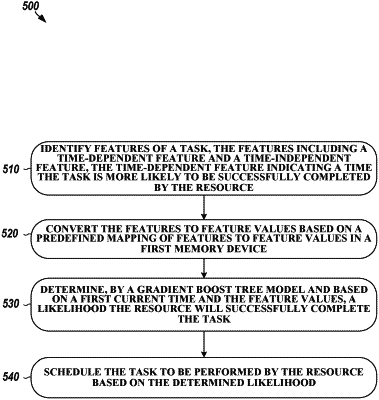| CPC G06F 9/4887 (2013.01) [G06F 9/4881 (2013.01); G06F 9/5005 (2013.01); G06F 18/21 (2023.01); G06N 20/00 (2019.01)] | 15 Claims |

|
12. A method of scheduling a resource to perform a task by a scheduler system, the method comprising:
determine feature values of features of a task based on a predefined mapping of the features of the task to the feature values in a first memory device, the features of the task including a time-dependent feature and a time-independent feature, the time-dependent feature indicating a time the task is more likely to be successfully completed by a resource;
determining, by a trained and deployed gradient boost tree model and using a first current time and the determined feature values as input to the trained and deployed gradient boost tree model, a likelihood the resource will successfully complete the task within a time window;
determining a specified amount of time has elapsed since the determined likelihood was determined, and re-determining the likelihood the resource will successfully complete the task, the likelihood re-determined by the gradient boost tree model based on a second current time and the determined feature values;
receiving an indication, at a time before the specified amount of time has elapsed since the likelihood was re-determined at the second current time, that a new feature for the task is available;
re-determining the likelihood the resource will successfully complete the task, the likelihood re-determined by the gradient boost tree model based on a third current time, the feature values, and a feature value for the new feature;
scheduling the task to be performed by the resource based on the re-determined likelihood at the third current time resulting in a schedule; and
performing the task by the resource based on the schedule.
|